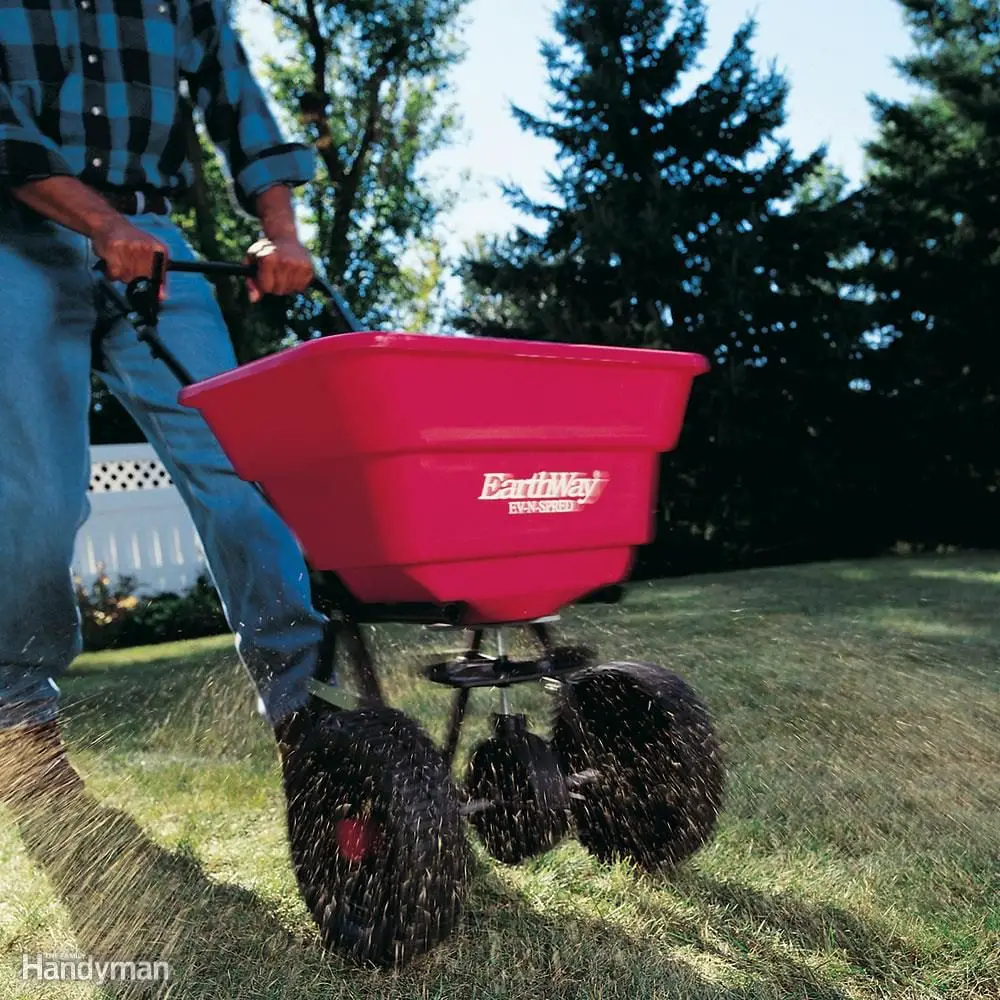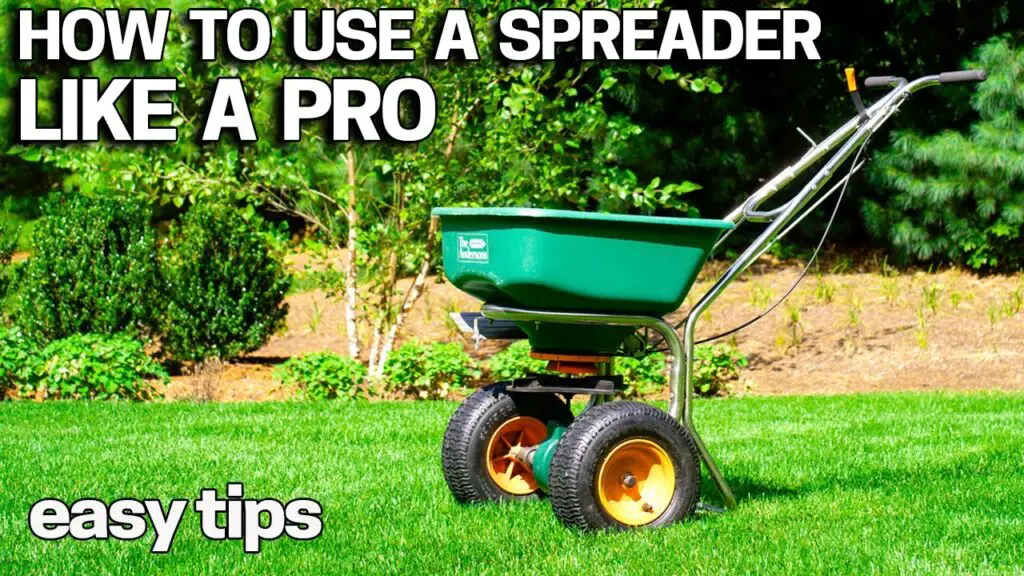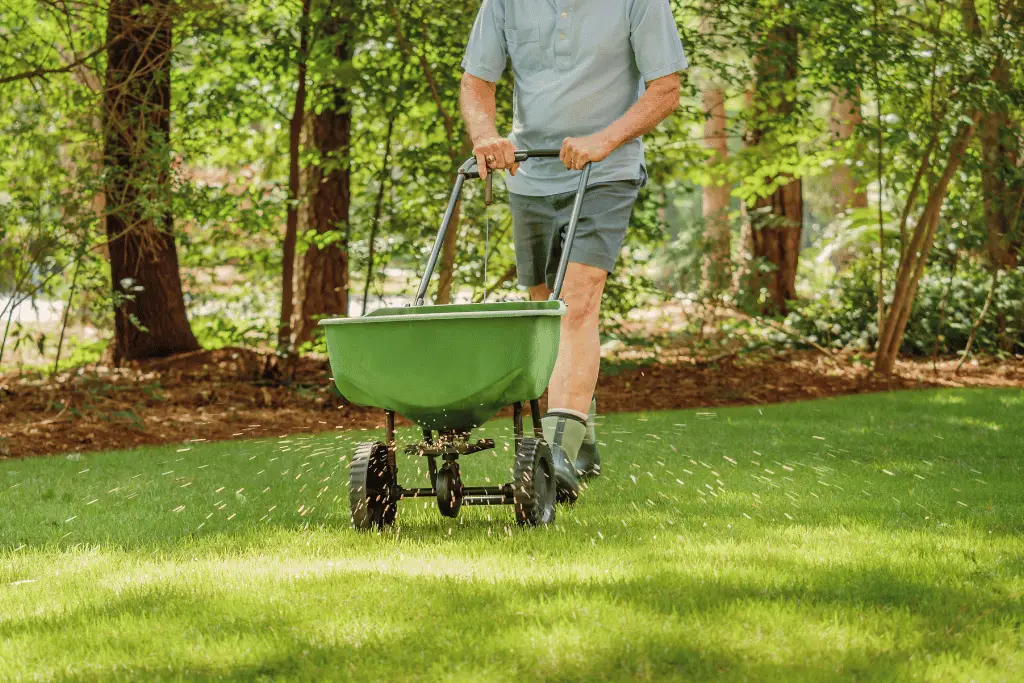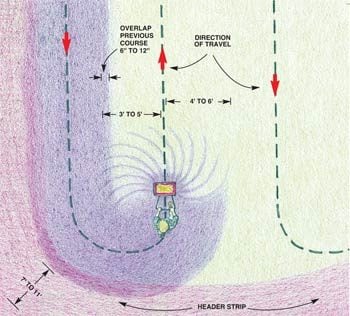This post may contain affiliate links which means I may receive a commission for purchases made through links. Learn more on my Private Policy page.
So, you’ve invested in a fertilizer spreader to give your garden the boost it needs, but now you’re not quite sure how to use it effectively. Don’t worry! In this article, we’ll guide you through the best practices for using a fertilizer spreader, so that you can achieve lush, healthy plants and a thriving garden. From adjusting the spreader settings to selecting the right type of fertilizer, we’ll cover all the essential tips and techniques to ensure that your fertilizer application is a success. It’s time to make the most of your investment and give your plants the nutrient-rich soil they deserve.

This image is property of www.familyhandyman.com.
Choosing the Right Spreader
Choosing the right spreader is essential for achieving an even distribution of fertilizer across your lawn. The size of your lawn will play a significant role in determining the spreader that suits your needs. If you have a small to medium-sized lawn, a handheld or drop spreader may be the best choice. On the other hand, for larger lawns, a broadcast spreader, which can cover a wider area in less time, may be more suitable.
Consider the size of your lawn
Take into account the size of your lawn when selecting a spreader. A spreader that is too small for the size of your lawn will result in an inefficient and time-consuming application, whereas a spreader that is too large may be challenging to maneuver in tight spaces or uneven terrain. Assess the dimensions of your lawn and choose accordingly.
Determine the type of fertilizer to be used
Different types of fertilizer require different spreading techniques. Some fertilizers are designed for use with certain spreader types, so it’s important to know the type of fertilizer you intend to use before choosing a spreader. Granular fertilizers are most commonly used with spreaders, but liquid fertilizers are also available for use with specific spreader models.
Evaluate different spreader types
There are various spreader types available in the market, each with its own advantages and limitations. Handheld spreaders offer precision and control, making them ideal for small areas or spot treatments. Drop spreaders provide accurate distribution, but they require multiple passes to cover large areas. Broadcast spreaders, whether push or tow-behind, can cover a wide area in a single pass, making them suitable for larger lawns. Consider the features and benefits of each spreader type to determine which one aligns best with your needs.
Preparing the Fertilizer
Properly preparing the fertilizer before loading it into the spreader is crucial for achieving effective results and ensuring your safety during the application process.
Read the instructions on the fertilizer packaging
Before using any fertilizer, thoroughly read and follow the instructions provided on the packaging. The instructions will outline important details such as the recommended application rate, any specific precautions, and the ideal environmental conditions for application. Adhering to these instructions will help you maximize the fertilizer’s effectiveness while minimizing any potential risks.
Use a well-ventilated area
When preparing the fertilizer, ensure you are in a well-ventilated area to avoid inhaling any potentially harmful fumes. If possible, perform the preparation outdoors or in a space with open windows or good airflow. This will help keep you safe and minimize any exposure to potentially hazardous substances.
Wear appropriate protective gear
Protecting yourself while handling fertilizers is essential. Wear appropriate protective gear, such as gloves, long sleeves, pants, and closed-toe shoes, to shield yourself from any potential skin contact or accidental spills. Additionally, consider wearing safety glasses or goggles to protect your eyes from any airborne particles during the preparation process.
Calibrating the Spreader
Calibrating your spreader contributes to the even and accurate distribution of fertilizer across your lawn. By following these steps, you can ensure that you are applying the correct amount of fertilizer and achieving optimal results.
Determine the application rate
Before calibrating your spreader, determine the recommended application rate for the specific fertilizer you are using. The application rate will typically be provided on the fertilizer packaging or in the accompanying instructions. This rate is often measured in pounds of fertilizer per 1,000 square feet. Knowing the application rate is crucial for setting your spreader correctly.
Perform a test on a small area
To fine-tune the spreader’s settings, perform a test on a small section of your lawn. Measure out the area and apply the fertilizer according to the recommended application rate. Take note of any adjustments needed to achieve an even and accurate distribution. By testing the spreader on a small area first, you can avoid the risk of over or under-applying fertilizer to your entire lawn.
Adjust the spreader settings
Based on the test results, adjust your spreader settings accordingly. Most spreaders have adjustable settings that control the flow of fertilizer. These settings may be indicated on a dial or lever, which can be adjusted to match the desired application rate. Make small adjustments and perform additional tests if necessary until you achieve an even and consistent spread pattern.
Loading the Spreader
Properly loading the spreader is crucial for ensuring an effective and efficient application of fertilizer to your lawn. By following these steps, you can ensure that you are loading the spreader correctly for optimal results.
Fill the hopper on a level surface
When loading the spreader, it is important to do so on a level surface to prevent any potential spills or uneven distribution of the fertilizer. Place the spreader on a flat and stable surface, such as a driveway or sidewalk, before adding the fertilizer into the hopper. This will help ensure that the fertilizer is evenly distributed as you move across your lawn.
Avoid overfilling the spreader
It may be tempting to overfill the spreader to avoid frequent refills. However, overfilling can lead to uneven distribution, clogging, or damage to the spreader. Follow the manufacturer’s guidelines or markings on the spreader’s hopper to determine the appropriate fill-level. Overfilling can also result in excess fertilizer being released, which can harm your lawn or the environment.
Use clean and dry fertilizer
Using clean and dry fertilizer is important for preventing clogging or uneven distribution of the product. Moisture or clumps in the fertilizer can impede the flow and block the spreader’s mechanism. Ensure that the fertilizer is free from any lumps or debris before loading it into the spreader. If necessary, break up any clumps or remove any debris before use.
This image is property of cdn2.tmbi.com.
Applying the Fertilizer
Applying the fertilizer correctly is essential for achieving an even and lush lawn. By following these steps, you can ensure that your fertilizer is evenly distributed, resulting in healthy grass growth.
Start at the perimeter of your lawn
To ensure an even distribution of fertilizer, begin by spreading along the perimeter of your lawn. This allows for a smooth transition between passes and prevents missed areas. By establishing a perimeter, you can then work your way inward, ensuring that every section of your lawn receives an equal amount of fertilizer.
Maintain a steady walking pace
As you walk across your lawn with the spreader, maintain a steady and consistent walking pace. This will help ensure that the fertilizer is applied evenly, preventing over or under-application. Avoid rushing or slowing down significantly, as this can result in uneven distribution and patchy areas.
Overlap slightly between passes
To achieve a uniform spread, overlap each pass slightly with the previous one. This will compensate for any slight inconsistencies in the spreader’s distribution pattern, ensuring that every part of your lawn receives an adequate amount of fertilizer. Pay particular attention to the areas where the spreader wheels pass, as they tend to leave gaps that can result in uneven growth.
Avoiding Environmental Impact
Using fertilizer responsibly is not only beneficial for your lawn but also for the environment. By following these practices, you can minimize the potential impact of fertilizer on surrounding ecosystems.
Avoid spreading near water bodies
When applying fertilizer, be mindful of any nearby water bodies such as ponds, lakes, or streams. Fertilizer runoff can contaminate water sources, leading to an imbalance in aquatic ecosystems. To prevent this, maintain a sufficient buffer zone between the application area and any water bodies. Follow local regulations and recommendations regarding the distance required to protect water sources.
Prevent fertilizer runoff
To minimize fertilizer runoff and its impact on the environment, be cautious when applying fertilizer to slopes, heavily compacted soil, or areas prone to erosion. These areas are more susceptible to runoff, which can carry excess fertilizer into water bodies or contaminate groundwater. Consider using erosion control methods, such as mulching or terracing, to prevent runoff and promote the absorption of nutrients into the soil.
Clean up any spills or excess fertilizer
Accidental spills or excess fertilizer should be promptly cleaned up to prevent them from being washed away into water bodies or contaminating other areas of your lawn. Use a broom or a rake to collect any spilled fertilizer and dispose of it properly. Avoid letting excess fertilizer sit on paved surfaces, as rain or water can wash it into storm drains, leading to water pollution.

This image is property of i.ytimg.com.
Post-Application Care
After applying fertilizer, certain measures should be taken to ensure the best results and to promote the well-being of your lawn. By following these steps, you can optimize the effects of the fertilizer and maintain a healthy lawn.
Water the lawn after spreading
Watering your lawn after applying fertilizer helps activate the nutrients and encourages their absorption into the soil. This step is particularly important if you are using a granular fertilizer. Follow the instructions provided on the fertilizer packaging regarding the recommended time and amount of water to apply. Adequate watering will help prevent the fertilizer from drying out and ensure that the nutrients penetrate the root zone of your grass.
Keep pets and children off the treated area
To avoid any accidental contact or ingestion of the fertilizer, keep pets and children off the treated area until it has been adequately watered and absorbed. Fertilizers contain various chemicals that can be harmful if ingested or inhaled. Restricting access to the treated area will help mitigate any potential risks and keep your loved ones safe.
Dispose of any remaining fertilizer properly
If there is any remaining fertilizer in the spreader after application, avoid discarding it on paved surfaces or household drains. Fertilizer runoff can harm the environment and contribute to water pollution. Instead, store any leftover fertilizer in a sealed container for future use or dispose of it in accordance with local regulations for hazardous waste disposal.
Maintenance and Storage
Proper maintenance and storage of your spreader are essential for its longevity and continued effectiveness. By following these practices, you can ensure that your spreader remains in good condition and ready for future use.
Clean the spreader after each use
After each use, clean the spreader thoroughly to remove any fertilizer residue or debris. This prevents clogging and corrosion, ensuring that the spreader operates efficiently for subsequent applications. Use a garden hose or a brush to remove any buildup. Pay close attention to the spreader’s mechanism, such as the hopper and the spreading plate, to remove any stuck debris or dried fertilizer.
Inspect and replace worn parts
Regularly inspect the spreader for any signs of wear or damage. Check the wheels, handle, and other components to ensure they are functioning properly. Replace any worn or broken parts promptly to avoid any issues during future applications. Consult the spreader’s user manual or contact the manufacturer for guidance on replacement parts.
Store the spreader in a dry and secure location
When not in use, store the spreader in a dry and secure location, such as a garage or a shed. Exposure to moisture and extreme weather conditions can cause rust or deterioration. Keep the spreader away from direct sunlight, as prolonged sun exposure may fade or damage certain materials. Storing the spreader properly will prolong its lifespan and maintain its performance.

This image is property of theplantbible.com.
Safety Precautions
When using a fertilizer spreader, it is important to prioritize safety at all times. By following these precautions, you can ensure your well-being and prevent any accidents or injuries.
Follow the manufacturer’s instructions
Always read and adhere to the manufacturer’s instructions provided with the spreader. The instructions will outline specific safety measures and guidelines for using the spreader effectively. Familiarize yourself with the equipment’s features, controls, and limitations, ensuring that you operate it in a manner consistent with its intended use.
Keep hands and feet clear of moving parts
Exercise caution and keep your hands and feet clear of any moving parts while operating the spreader. The spreading mechanism can have rotating or moving parts that can cause injury if not handled appropriately. Be mindful of your body positioning and maintain a safe distance from the spreader’s working components.
Store fertilizers in a cool and dry place
When storing fertilizers, ensure they are kept in a cool and dry place. Prolonged exposure to extreme temperatures or moisture can affect the quality and effectiveness of the fertilizer. Additionally, store fertilizers in containers that are resistant to leaks or spills to prevent any accidental contamination or harm.
Conclusion
Using a fertilizer spreader correctly is essential for achieving a healthy and vibrant lawn. By considering the size of your lawn, determining the type of fertilizer, and evaluating different spreader types, you can choose the right spreader for your needs. Preparing the fertilizer properly, calibrating the spreader, and safely loading and applying the fertilizer will ensure an even distribution and effective results. By avoiding environmental impact, practicing post-application care, and maintaining the spreader, you can promote the well-being of your lawn while minimizing any potential risks. Remember to prioritize safety precautions and consult the manufacturer’s instructions for optimal usage. With these best practices in mind, you can achieve a lush and attractive lawn that stands out in your neighborhood.

This image is property of plantcaretoday.com.
This post may contain affiliate links which means I may receive a commission for purchases made through links. Learn more on my Private Policy page.


